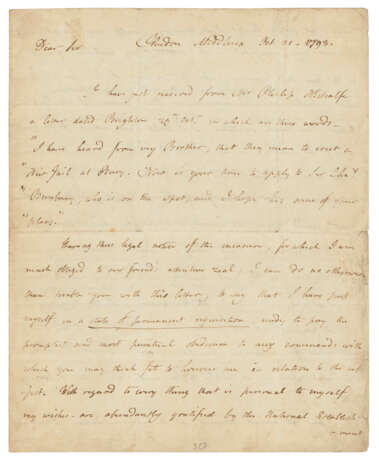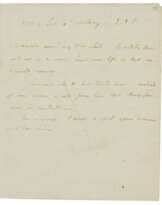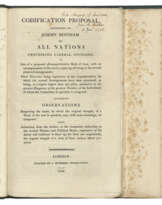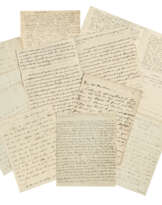ID 1109081
Lot 281 | Jeremy Bentham (1748-1832)
Estimate value
£ 3 000 – 5 000
Autograph letter signed (‘Jeremy Bentham’) to Sir Charles Bunbury (‘Dear Sir’), Hendon, Middlesex, 31 October 1793
3 pages, 232 x 188mm, bifolium, docketed in another hand. Provenance: Christie's South Kensington, 22 May 1998, lot 154.
The Panopticon: Jeremy Bentham on prison reform. Bentham has just received a letter from a Philip Metcalfe informing him that a new jail is to be built at Bury and urging him to apply to Bunbury, who shares some of his plans. He declares himself ‘in a state of permanent requisition', placing himself at Bunbury's command: 'With regard to every thing that is personal to myself, my wishes are abundantly gratified by the National establishment: but for the benefit of the country, should my humble endeavours prove successful in its service, my ambition goes to no less than becoming, under the auspices of Sir Charles Bunbury, Jailor, as Lord Kenyon is Chief Justice of all England. Either I am mistaken, or I could save money to the gentlemen of the county, to say nothing of what they will look upon as the more important saving, that of misery and wickedness to the prisoners'. His recommendation, he continues, is to wait until the 'the practicability and utility of the Panopticon mode of construction has been proved or disproved by the experiment which is so speedily to be made, and upon so large a scale', adding that he is preparing a bill for Pitt for that purpose.
Bentham developed the idea of the Panopticon – a circular institutional building designed for maximum oversight by the smallest possible number of managers – in the late 1780s; on his return from Russia and after abortive early approaches to establish the Panopticon prison in Ireland, he focused instead on its foundation in England, writing to William Pitt in 1791 to suggest he might develop the scheme himself. He received no immediate reply, but slowly began to win support and political allies, including William Wilberforce and the recipient of the present letter, Sir Charles Bunbury. By May 1792 the home secretary, Henry Dundas, had taken an interest in the project. In May 1793 Bunbury, who was one of the commissioners appointed under the 1779 Penitentiary Act, spoke in the House of Commons about the scandals surrounding transportation to Botany Bay and recommended Bentham's plan to the government, as one where 'well regulated prisons calculated to reform offenders, and to convert the dissolute and idle into good and industrious subjects, would be provided at a cheaper rate than vessels in the Thames'. Bentham spent some sixteen years of his life developing and refining his ideas for the Panopticon and hoping that the government would adopt the plan for a National Penitentiary appointing him as contractor-governor, but his proposals were never to come to fruition.
| Artist: | Jeremy Bentham (1748 - 1832) |
|---|---|
| Place of origin: | England |
| Artist: | Jeremy Bentham (1748 - 1832) |
|---|---|
| Place of origin: | England |
| Address of auction |
CHRISTIE'S 8 King Street, St. James's SW1Y 6QT London United Kingdom | |||||
|---|---|---|---|---|---|---|
| Preview |
| |||||
| Phone | +44 (0)20 7839 9060 | |||||
| Buyer Premium | see on Website | |||||
| Conditions of purchase | Conditions of purchase |











